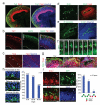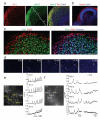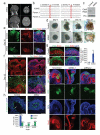Cerebral organoids model human brain development and microcephaly
- PMID: 23995685
- PMCID: PMC3817409
- DOI: 10.1038/nature12517
Cerebral organoids model human brain development and microcephaly
Abstract
The complexity of the human brain has made it difficult to study many brain disorders in model organisms, highlighting the need for an in vitro model of human brain development. Here we have developed a human pluripotent stem cell-derived three-dimensional organoid culture system, termed cerebral organoids, that develop various discrete, although interdependent, brain regions. These include a cerebral cortex containing progenitor populations that organize and produce mature cortical neuron subtypes. Furthermore, cerebral organoids are shown to recapitulate features of human cortical development, namely characteristic progenitor zone organization with abundant outer radial glial stem cells. Finally, we use RNA interference and patient-specific induced pluripotent stem cells to model microcephaly, a disorder that has been difficult to recapitulate in mice. We demonstrate premature neuronal differentiation in patient organoids, a defect that could help to explain the disease phenotype. Together, these data show that three-dimensional organoids can recapitulate development and disease even in this most complex human tissue.
Figures






Comment in
-
Developmental neuroscience: Miniature human brains.Nature. 2013 Sep 19;501(7467):319-20. doi: 10.1038/nature12552. Epub 2013 Aug 28. Nature. 2013. PMID: 23995687 No abstract available.
-
Stem cells: Small but beautiful.Nat Rev Neurosci. 2013 Oct;14(10):665. doi: 10.1038/nrn3600. Epub 2013 Sep 12. Nat Rev Neurosci. 2013. PMID: 24026116 No abstract available.
-
Cerebral organoids in a dish: progress and prospects.Cell. 2013 Sep 26;155(1):19-20. doi: 10.1016/j.cell.2013.09.010. Cell. 2013. PMID: 24074857 Free PMC article.
-
Build-a-brain.Cell Stem Cell. 2013 Oct 3;13(4):377-8. doi: 10.1016/j.stem.2013.09.010. Cell Stem Cell. 2013. PMID: 24094317
-
Neuroscience. What are mini-brains?Science. 2013 Oct 11;342(6155):200-1. doi: 10.1126/science.1245812. Science. 2013. PMID: 24115427 No abstract available.
-
Stem cells: The developing human brain--modeled in a dish.Nat Methods. 2013 Oct;10(10):929. doi: 10.1038/nmeth.2674. Nat Methods. 2013. PMID: 24161970 No abstract available.
-
Modeling human brain development with cerebral organoids.Stem Cell Res Ther. 2013;4(6):154. doi: 10.1186/scrt384. Stem Cell Res Ther. 2013. PMID: 24367992 Free PMC article.
-
Cerebral organoids model human brain development and microcephaly.Mov Disord. 2014 Feb;29(2):185. doi: 10.1002/mds.25740. Epub 2013 Dec 27. Mov Disord. 2014. PMID: 24375826 No abstract available.
-
Building brains: using brain organoids to study neural development and disease.Brain. 2019 Nov 1;142(11):e65. doi: 10.1093/brain/awz308. Brain. 2019. PMID: 31591637 No abstract available.
References
-
- Götz M, Huttner WB. The cell biology of neurogenesis. Nat Rev Mol Cell Biol. 2005;6:777–788. - PubMed
-
- Fietz SA, et al. OSVZ progenitors of human and ferret neocortex are epithelial-like and expand by integrin signaling. Nat Neurosci. 2010;13:690–699. - PubMed
-
- Hansen DV, Lui JH, Parker PRL, Kriegstein AR. Neurogenic radial glia in the outer subventricular zone of human neocortex. Nature. 2010;464:554–561. - PubMed
Publication types
MeSH terms
Grants and funding
LinkOut - more resources
Full Text Sources
Other Literature Sources
Research Materials

